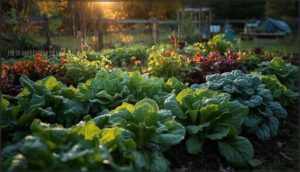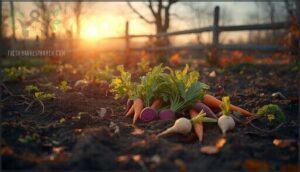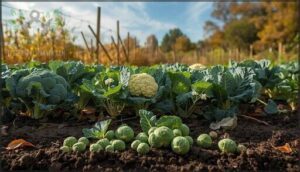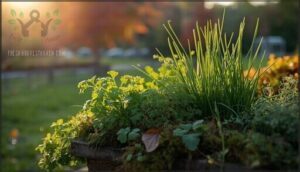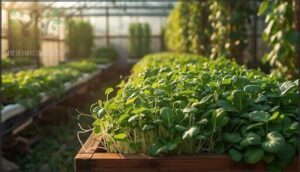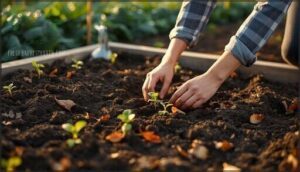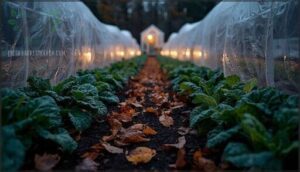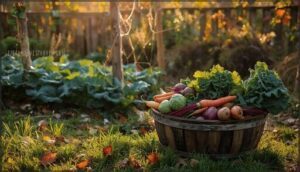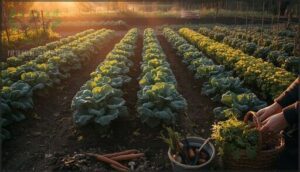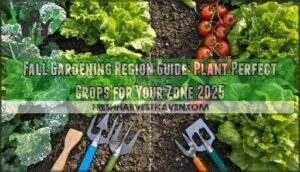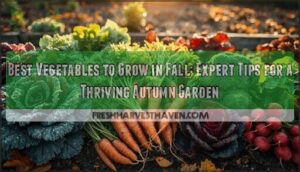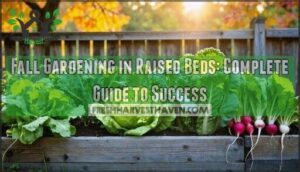This site is supported by our readers. We may earn a commission, at no cost to you, if you purchase through links.
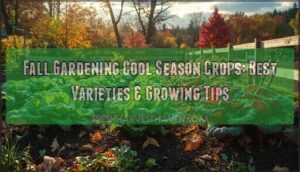
Your fall garden can outperform your summer harvest if you choose the right plants. Cool-season crops don’t just tolerate chilly weather; they demand it, developing textures and tastes impossible to achieve during summer’s heat.
Understanding which varieties thrive in autumn’s conditions and how to protect them through early frosts transforms those empty beds into productive space well past the first freeze.
Table Of Contents
- Key Takeaways
- Best Cool-Season Crops for Fall Gardening
- Leafy Greens (Spinach, Lettuce, Kale, Arugula, Swiss Chard)
- Root Vegetables (Carrots, Beets, Radishes, Turnips, Parsnips, Rutabaga)
- Brassicas (Broccoli, Cauliflower, Cabbage, Brussels Sprouts, Kohlrabi)
- Fall Herbs (Cilantro, Parsley, Chives, Sage, Thyme, Dill, Fennel)
- Microgreens and Fast-Maturing Greens
- Timing and Techniques for Fall Planting
- Extending The Fall Growing Season
- Harvesting and Storing Fall Vegetables
- Maximizing Nutrition and Sustainability in Fall Gardens
- Frequently Asked Questions (FAQs)
- Conclusion
Key Takeaways
- Cool-season crops like spinach, kale, carrots, and brassicas don’t just tolerate cold—they require it to develop sweeter flavors and denser nutrition through biochemical processes that convert starches into sugars when temperatures drop.
- Timing your fall plantings around your first frost date and using season-extension tools like row covers, cold frames, and mulch can push your harvest 2-6 weeks later while maintaining crops through winter in many zones.
- Proper storage techniques tailored to each crop type—like keeping root vegetables at 32-40°F with 90-95% humidity or curing sweet potatoes before cold storage—can preserve your fall harvest for 4-7 months.
- Fall gardening builds soil health for future seasons through cover cropping and crop rotation, which reduces fertilizer needs by up to 45 kg N/ha, cuts erosion by 33%, and improves carbon sequestration while you harvest nutrient-dense vegetables.
Best Cool-Season Crops for Fall Gardening
Fall gardening opens the door to a whole lineup of crops that actually prefer cooler temperatures over summer’s heat. You’ll find that leafy greens, root vegetables, brassicas, herbs, and quick-growing microgreens all thrive when autumn settles in.
Here’s what you can grow this season to fill your garden—and your table—well into winter.
Leafy Greens (Spinach, Lettuce, Kale, Arugula, Swiss Chard)
Leafy greens are nutritional powerhouses that thrive when nights turn crisp. Spinach bolling becomes less likely in cooler temperatures, while kale varieties sweeten after frost. Here’s what you should plant:
- Spinach – Tolerates temps down to 40°F and delivers 2,813 IU of vitamin A per cup
- Lettuce – Matures in 30–45 days with looseleaf varieties performing best
- Kale – Survives frosts to 25°F and provides outstanding lutein content
- Arugula – Ready in 40 days with arugula benefits including nitrate-rich leaves
- Swiss Chard – Manages mild freezes and offers adaptable chard recipes
Understanding the health benefits of these crops can help you make informed decisions. Harvest continuously for maximum yield.
Root Vegetables (Carrots, Beets, Radishes, Turnips, Parsnips, Rutabaga)
Root crops excel in fall gardens, converting cool temperatures into complex sugars that boost flavor. Carrots, Beets, Radishes, and Turnips handle light frosts beautifully while developing sweeter profiles. You’ll achieve best germination with soil temperatures between 45–85°F. Radishes mature fastest at 20–25 days, making them perfect for fall harvesting.
For vegetable storage success, rutabaga keeps six months when properly topped. Practice crop rotation to boost yields—loose, stone-free soil prevents deformed root crops during development.
To secure a successful harvest, consider using fall garden planning techniques.
Brassicas (Broccoli, Cauliflower, Cabbage, Brussels Sprouts, Kohlrabi)
Brassicas transform frost into flavor, with Brussels Sprouts developing 20% higher sugar content after cold exposure. Cold-hardy varieties like ‘Winterbor’ kale and ‘January King’ cabbage endure temperatures down to 15°F.
Start broccoli and cauliflower transplants 10–12 weeks before frost; they’ll mature in 55–75 days. Space plants 15 inches apart to prevent disease, and maintain soil temperatures above 41°F for seed germination.
Rotate brassica crops every three years to reduce pest pressure from cabbage root fly and black rot.
Fall Herbs (Cilantro, Parsley, Chives, Sage, Thyme, Dill, Fennel)
Beyond brassicas, herbs like Cilantro, Parsley, and Thyme thrive in autumn’s chill. Parsley tolerates temperatures to 10°F and overwinters reliably in zones 3–9. Plant perennial Chives, Sage, and Thyme six weeks before frost for strong root establishment.
Cilantro and Dill excel as cool-season annuals, maturing in 40–50 days when soil drops below 85°F. Fennel yields 0.2–0.3 kg per square foot in sheltered fall spots.
These Cold Hardy Herbs anchor your Herb Garden Planning and Winter Herb Care strategy while delivering outstanding Fall Harvest Tips.
Microgreens and Fast-Maturing Greens
Your fastest reward? Microgreens and Fast-Maturing Greens deliver nutrient-dense harvests in 7–21 days. Radish and broccoli microgreens pack 4–40 times more vitamins than mature leafy greens, thriving in greenhouse production or vertical farming setups.
These cool-season crop selections excel in fall gardening tips for maximizing microgreen benefits while optimizing space and fast harvest windows with enhanced nutrient density.
Timing and Techniques for Fall Planting
Getting your fall garden right comes down to timing and technique. You’ll need to know your frost dates, decide between seeds and transplants, and prepare your soil properly for cooler conditions.
Let’s walk through the key strategies that’ll help you establish a thriving autumn garden.
Understanding Frost Dates and Zone Considerations
Your frost dates dictate everything—they’re the invisible deadline that separates harvest from heartbreak. Check your USDA hardiness zone to pinpoint average first fall frost, but remember climate shift has delayed frost by one to three weeks in many regions since the 1990s.
Local weather forecasting and gardening calendars help you time cool-season crops precisely, ensuring frost-tolerant varieties mature before freezing temperatures strike.
Direct Sowing Vs. Transplants
Choose between direct sowing and transplanting based on your crop’s root structure and maturity needs. Taproots vegetables like carrots and radishes demand direct sowing—transplanting causes forking in most specimens.
Cool-season brassicas such as broccoli and cabbage thrive as transplants, maturing weeks faster despite brief transplant shock.
Soil temperature above 40°F ensures seed germination for direct-sown seedlings, while transplanting seedlings works best near 60°F for reliable crop establishment.
Succession Planting for Continuous Harvests
Stagger your seed sowing every 14–21 days to keep fresh produce rolling in through harvest season. Radishes and arugula mature fastest, followed by lettuce and spinach—perfect for succession planting cool-season crops in fall gardening.
Plant spacing matters: crowded beds reduce air circulation and slow growth stages. Rotate crop selection across beds to prevent soil depletion and pest buildup, maintaining ideal harvest scheduling throughout autumn.
Soil Preparation and Mulching for Fall Crops
Your fall garden needs a strong foundation—think of soil prep as the insurance policy for your harvest. Target a pH of 6.0–7.0 and layer 2–3 inches of compost to boost organic matter by 1–2%.
Here’s your four-step soil prep checklist:
- Test soil pH and adjust with lime or sulfur as needed
- Work in aged compost or manure (3–4 months cured minimum)
- Apply 3–4 inches of straw or shredded leaf mulch to suppress weeds and retain moisture
- Add phosphorus and potassium amendments to strengthen frost tolerance in brassicas and greens
Mulch materials keep soil temps stable and cut erosion by 60% during fall rains, protecting your cool-season crops through unpredictable weather. Proper nutrient cycling now means stronger roots and sweeter harvests after the first frost hits.
Seed Germination in Cooler Soils
Cooler soil acts like a brake pedal on germination—enzymatic activity drops by over 50% below 50°F, slowing seed sprouting considerably. Most cool-season crops germinate between 40–60°F, but germination rates suffer when soil temperature dips too low.
You can boost success with seed stratification, pre-soaking at 68°F, or using heat mats to raise soil temperature 5–10°F. Cold frames and cloches trap warmth, improving frost tolerance and uniform emergence for cool weather plantings.
Extending The Fall Growing Season
When cold weather threatens to end your fall harvest, a few simple tools can keep your crops thriving well past the first frost. The right season-extension method depends on your budget, available space, and how much protection your plants need.
Let’s look at the most effective ways to shield your cool-season vegetables from autumn’s chill.
Using Row Covers, Cold Frames, and Hoop Houses
When temperatures drop, season extension tools become your best allies for keeping cool-season crops productive well into winter. A row cover offers 2 to 8°F of frost protection depending on fabric weight, while a cold frame can push your harvest zone 2–4 weeks later into fall.
Hoop houses create conditions up to a full hardiness zone warmer, enabling year-round growing in many climates and boosting yields dramatically for greens and brassicas alike.
Mulching and Frost Protection Methods
Beyond your row covers and cold frames, mulch acts as a thermal blanket that can reduce soil heat loss by up to 75%. Apply a 3–4 inch layer of straw or leaves after soil temperatures drop below 50°F but before hard frost hits.
This combination—mulch materials paired with frost protection fabric—maintains root-zone warmth 2–4°C above ambient air, shielding crops from freeze damage while boosting soil moisture retention by over 25% for stronger winter gardening performance.
Overwintering Hardy Vegetables
With proper insulation and protection, you can keep a steady supply of fresh vegetables even after your first hard freeze. Overwintering hardy greens like spinach, kale, and arugula—plus root crops such as carrots, beets, and parsnips—transforms your garden into a productive space through the coldest months.
Here’s what survives best with protection:
- Carrots tolerate 0°F under mulch and sweeten with cold exposure
- Spinach endures down to 0°F, often regrowing in spring after winter dieback
- Kale and Brussels sprouts withstand 15°F with row covers or low tunnels
- Leeks and parsnips remain harvestable at 0°F when properly mulched
- Beets and turnips survive 15°F while converting starches to sugars
Apply 4+ inches of straw mulch before freeze periods to insulate roots and maintain soil warmth. Deep watering before cold snaps improves thermal retention, keeping root zones 5°F warmer than exposed beds.
Low tunnels boost air temperature by 10°F, substantially extending frost tolerance for vegetables throughout winter. Harvest only when temperatures rise above freezing to prevent tissue damage—and you’ll enjoy yields 10–20% heavier than fall-lifted crops, with noticeably sweeter flavors from cold-season sugar concentration.
Choosing Cold-Tolerant Varieties
Mulching and protection only work if you start with varieties bred for winter survival. Select cultivars labeled “winter,” “frost hardy,” or “overwintering” on seed packets—they’re specifically developed to handle sustained subfreezing temperatures.
For instance, purple kale and purple-sprouting broccoli tolerate 15°F and resist rot better than green varieties. Carrots, parsnips, and Brussels sprouts marked as cold-hardy survive down to 20°F with minimal loss, while standard types fail.
Choose wisely, and your fall garden becomes a productive cold-weather asset.
Harvesting and Storing Fall Vegetables
Knowing when to harvest your fall crops and how to store them properly makes all the difference between a few weeks of fresh eating and months of homegrown produce. Different vegetables have their own signals for peak ripeness, and each requires specific storage conditions to stay fresh.
Let’s walk through the best practices for getting the most out of your cool-season harvest.
Optimal Harvest Times for Cool-Season Crops
Timing is everything when harvesting fall gardening coolseason crops—catch them at their peak and you’ll taste the difference.
Spinach reaches maturity in 37–45 days when soil temperatures hold between 50–60°F. Carrots need 60–70 days for fresh use, while beets are ready at 50–60 days. Radishes mature fastest at 25–35 days. Kale sweetens after frost, ready in 55–75 days.
Monitor weather closely to harvest before hard freezes damage tender crops, ensuring best flavor and frost tolerance of vegetables.
Continuous Harvest Techniques for Greens
Cut and come again methods transform leafy green vegetables into extended producers in your fall garden. Harvest lettuce and mizuna by cutting leaves 0.5–1 inch above the crown, and you’ll gain 3–4 harvests spaced 7–15 days apart. This regrowth strategy boosts total yield by 30–40% compared to single cuts.
Plant succession sowing every two weeks for continuous harvest windows spanning 8–10 weeks. Pair this with greens rotation across cool-season vegetables and brassicas to maximize harvest flow through frost.
Root Crop Storage and Winter Preservation
Beyond season-extension methods, you’ll need smart winter food storage strategies to keep your root crops crisp and nutritious from fall garden through spring. Root crops excel at overwintering when properly stored.
Five keys to successful root cellar design and storage humidity control:
- Temperature range: Store beets, carrots, and parsnips between 32–40°F with 90–95% humidity to prevent shriveling and extend shelf life up to 4 months.
- Immediate handling: Pack roots in moist sawdust within 24 hours of harvest—delays drop acceptability from 75% to 50% after just 4 weeks.
- Crop rotation planning: Inspect monthly and remove spoiled vegetables to reduce overall loss by 10%.
- Frost protection methods: Cure sweet potatoes for 5–7 days at 85°F before cool storage for 7-month preservation.
- Winter harvest strategies: Choose late-maturing carrot varieties for 5–6 month storage potential with proper humidity control.
Trim leaves 1–2 cm above crowns on smooth, undamaged roots for lowest spoilage rates.
Storing Herbs and Microgreens
Fresh herbs and microgreens require careful handling due to their delicate tissues, which can quickly lose quality without proper cool, dry storage and humidity control methods. By following these herb storage tips, your fall gardening harvest will stay vibrant for longer.
| Storage Method | Shelf Life & Conditions |
|---|---|
| Fresh herbs (cilantro, parsley) | 21 days at 32°F, >95% humidity |
| Microgreens (mustard, arugula) | 14 days at 41°F in polyethylene bags |
| Freeze-dried herbs | 12 months in sealed jars at room temp |
| Fresh basil (chill-sensitive) | 14 days minimum at 50°F to avoid damage |
Microgreen packaging is crucial, as LDPE bags stored at 41°F reduce tissue breakdown by 40% compared to other materials. For cool-season crops like dill and chives, refrigerate immediately after harvest to lower respiration rates and preserve flavor compounds.
Maximizing Nutrition and Sustainability in Fall Gardens
Fall gardening isn’t just about growing food—it’s about growing better food while building healthier soil for seasons to come. Cool-season crops pack more nutrients when they mature in chilly weather, and your planting choices can actively improve your garden’s long-term vitality.
Let’s look at how you can boost nutrition, protect your soil, and adapt to shifting fall conditions.
Nutritional Benefits of Cool-Season Crops
Cool-season crops deliver outstanding vitamin content and mineral density that intensify with frost exposure. Phytochemical benefits from these nutrient-rich vegetable gardening staples support immune function and reduce inflammation. Here’s what you’re harvesting:
- Kale and spinach provide complete daily vitamin A, C, and K requirements while delivering lutein for cardiovascular protection.
- Brassica oleracea var italica (broccoli) concentrates glucosinolates that convert into cancer-fighting isothiocyanates.
- Root vegetables boost beta-carotene by 241% post-frost, enhancing antioxidant properties.
- Microgreens pack 4–40 times higher nutrient bioavailability than mature plants, maximizing nutrition per square foot.
Cool-season vegetables genuinely earn their reputation as powerhouse crops for your fall garden.
Cover Crops and Soil Health
Your fall cover crops work like a savings account for soil health—deposits made now pay dividends next season. Legume-based species deliver nitrogen fixation that reduces fertilizer needs by 45 kg N/ha while building organic matter by 0.32% annually.
Mixed cover crop rotations cut soil erosion by 33%, boost carbon sequestration to 0.77 metric tons CO₂-equivalent per hectare yearly, and improve soil moisture retention by 16%.
Strategic crop rotation with winter rye or hairy vetch transforms soil preparation for spring cool-season crop selection.
Sustainable Pest and Disease Management
Integrated pest management combines biological controls with organic methods to protect your cool-season crops. Pest monitoring lets you spot trouble early—aphids colonizing young brassicas, slugs targeting lettuce—before populations explode.
Beauveria bassiana fungi and parasitoid wasps achieve 80% pest control within two weeks, while neem oil and Bt target 90% of caterpillar larvae without harming beneficial insects.
Crop rotation and companion planting with herbs boost predatory insect presence by 35%, creating ecological balance. This approach cuts pesticide use by 50% while reducing pest-related crop loss by 61%.
Adapting to Changing Climate and Frost Patterns
Beyond ecological pest control, your fall garden needs climate resilience strategies. Frost dates have shifted 10–14 days later since 1900, but erratic freeze events now spike 20% more often.
Track real-time weather forecasting and select cold-tolerant cool-season crop varieties with proven frost tolerance of vegetables. Row covers and cold frames buffer temperature swings, extending the growing season by three to six weeks.
Adjust fall planting timelines as 57% of gardeners already do—and consider crop insurance if market sales depend on your harvest.
Frequently Asked Questions (FAQs)
What watering schedule works best for fall crops?
Water your fall crops 1–2 times weekly, aiming for 3–4 inches deep to encourage strong roots. Seedlings need moisture every 1–2 days, while established plants thrive with weekly soaking.
Adjust based on rainfall and soil moisture—cooler temperatures reduce water demand by roughly 20–30% compared to summer.
Can I grow fall vegetables in containers?
You can absolutely grow cool-season vegetables in containers—think of it as bringing the harvest right to your doorstep. Spinach, lettuce, kale, radishes, and herbs thrive in pots with proper drainage and depth.
Choose containers at least twelve inches deep for root crops, use quality soil mixtures, and you’ll enjoy fresh, frost-hardy varieties all season long.
How do I deal with autumn pests?
Fall pests like aphids, cabbage worms, and slugs thrive in cool weather.
Use biological pest control with beneficial insects, practice crop rotation for pest management, and apply row covers for slug removal and cutworm prevention.
Hand-pick visible pests early.
What spacing should I use for fall plantings?
Getting your plant density right is like setting the table for success—too crowded and plants compete, too sparse and you waste precious garden real estate. Proper garden layout with adequate row spacing ensures airflow, reduces disease, and gives your cool-season crop selection room to thrive.
For larger fall crops like cabbage and broccoli, allow 1-2 feet within rows and 3 feet between them. Smaller greens like arugula need just 4-6 inches, while root vegetables require 2-4 inches in-row spacing.
Thin seedlings when they’re about an inch tall—this key step prevents crowding. Adjust seed depth to ¼-⅓ inch for most fall planting, and consider succession planting strategies to fully utilize yields. Remember, generous spacing now means healthier harvests later, so resist the urge to cram everything in.
Should I fertilize differently in fall versus spring?
Yes—fall fertilization emphasizes slow-release and organic options that align with reduced microbial activity in cooler soils. Cooler soil temperatures slow nutrient mineralization, so fall application methods focus on soil preparation and steady nutrient availability.
Spring demands quick-release fertilizers for rapid growth.
Conclusion
Your fall garden doesn’t compete with summer’s bounty—it offers something entirely different. Just as certain wines need cool cellars to develop complexity, fall gardening cool season crops require dropping temperatures to reveal their full potential.
The frost that devastates August plantings actually signals your spinach and carrots to intensify their sugars, creating flavors you can’t replicate in July.
Those empty beds aren’t waiting for spring; they’re ready now. Plant strategically, protect wisely, and you’ll harvest vegetables with depth that warm-weather crops never achieve.
- https://www.crozetgazette.com/2025/08/08/nows-the-time-to-plan-plant-your-fall-garden/
- https://harvesttotable.com/cool-season_vegetable_varietie/
- https://gardeningsolutions.ifas.ufl.edu/plants/edibles/vegetables/cool-season-vegetables/
- https://phsonline.org/for-gardeners/gardeners-blog/vegetables-plant-fall-garden
- https://sustainableagriculture.net/blog/climate-change-adaptation-report/

